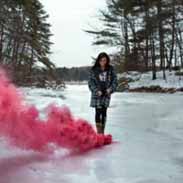Geol Sedimentary And Metamorphic Rocks – Flashcards
Unlock all answers in this set
Unlock answersquestion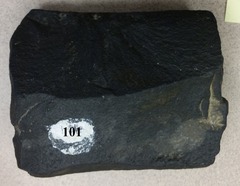
basalt aphanitic mafic

answer
igneous
question
pumice porous felsic
answer
igneous
question
obsidian glassy mafic
answer
igneous
question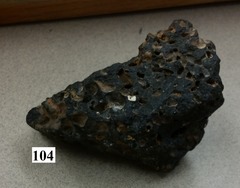
vesicular basalt porous mafic

answer
igneous
question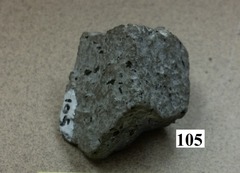
rhyolite porphyry porphyry felsic

answer
igenous
question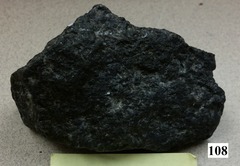
gabbro phaneritic mafic

answer
igenous
question
scoria porous mafic
answer
igenous
question
andesite Aphanitic intermediate
answer
igenous
question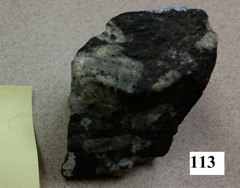
basalt porphyry porphyritic mafic

answer
igenous
question
peridotite phaneritic mafic
answer
igenous
question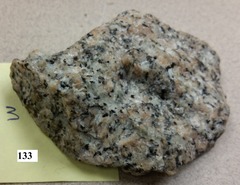
granite phaneritic felsic

answer
igenous
question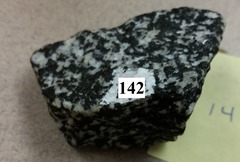
diorite phaneritic intermediate

answer
igenous
question
sandstone clastic silicate
answer
sedimentary
question
breccia clastic silicate
answer
sedimentary
question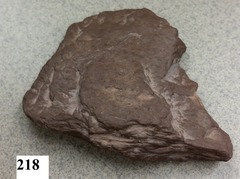
shale clastic silicate

answer
sedimentary
question
fossiliferous limestone clastic carbonate
answer
sedimentary (fizzes)
question
lignite coal clastic organic
answer
sedimentary
question
bituminous coal crystalline organic
answer
sedimentary
question
conglomerate clastic silicate
answer
sedimentary
question
chert crystalline silicate
answer
sedimentary
question
peat clastic organic
answer
sedimentary
question
micrite clastic carbonate
answer
sedimentary(Fizzes)
question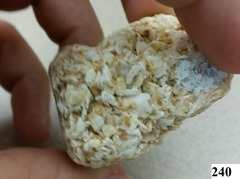
coquina clastic carbonate

answer
sedimentary
question
slate foliated alumnous
answer
metamorphic
question
quartzite nonfoliated quartzo-feldspathic
answer
metamorphic
question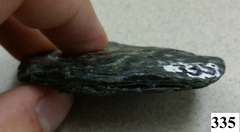
phyllite foliated Aluminous

answer
metamorphic
question
schist foliated Aluminous
answer
metamorphic
question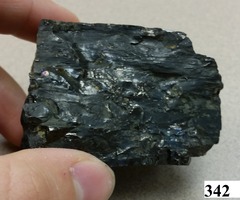
anthracite coal nonfoliated organic

answer
metamorphic
question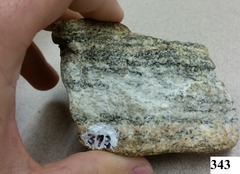
gneiss foliated aluminous or quartzo-feldspathic

answer
metamorphic
question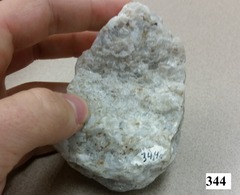
marble nonfoliated calcareous composition

answer
metamorphic (fizzes)
question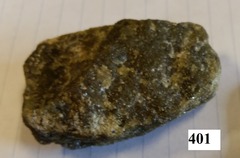
olivine nonmetallic silicate

answer
mineral
question
pyroxene nonmetallic silicate
answer
mineral
question
amphibole nonmetallic silicate
answer
mineral
question
plagioclase feldspar nonmetallic silicate
answer
mineral
question
orthoclase feldspar nonmetallic silicate
answer
mineral
question
quartz nonmetallic silicate
answer
mineral
question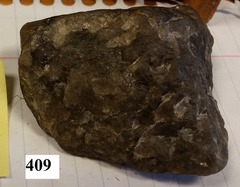
quartz (smoky) nonmetallic silicate

answer
mineral
question
quartz (rose) nonmetallic silicate
answer
mineral
question
biotite mica nonmetallic silicate
answer
mineral
question
muscovite mica nonmetallic silicate
answer
mineral
question
talc nonmetallic silicate
answer
mineral
question
kaolinite nonmetallic silicate
answer
mineral
question
graphite metallic native element
answer
mineral
question
hematite nonmetallic oxide
answer
mineral (leaves red streak)
question
hematite metallic oxide
answer
mineral (leaves red streak)
question
magnetite metallic oxide
answer
mineral
question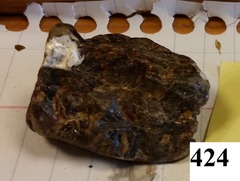
sphalerite metallic sulfide

answer
mineral
question
pyrite metallic sulfide
answer
mineral
question
galena metallic sulfide
answer
mineral
question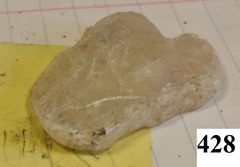
gypsum nonmetallic sulfate

answer
mineral
question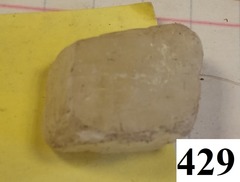
calcite nonmetallic carbonate

answer
mineral (fizzes)
question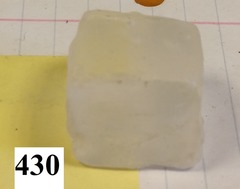
halite nonmetallic halide

answer
mineral
question
fluorite nonmetallic halide
answer
mineral
question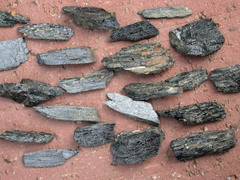
Amphibole

answer
Color Dark green, dark brown, black Cleavage Two directions that meet at 56 and 124 degrees, uneven fracture - vitreous
question
Biotite Mica
answer
Dark colored mica; one perfect cleavage into flexible sheets
question
Calcite
answer
olor Usually white but also colorless, gray, red, green, blue, yellow, brown, orange Streak White Luster Vitreous Diaphaneity Transparent to translucent Cleavage Perfect, rhombohedral, three directions Mohs Hardness 3 Specific Gravity 2.7 Diagnostic Properties Rhombohedral cleavage, powdered form effervesces weakly in dilute HCl, curved crystal faces and frequent twinning Chemical Composition CaCO3 Crystal System Hexagonal
question
Fluorite
answer
Commonly in cube-shaped crystals with four cleavage directions cutting corners of the cube
question
Galena
answer
Commonly in cube-shaped crystals with three perfect cleavages at 90 degrees
question
Graphite

answer
Greasy feel- leaves a mark on paper
question
Gypsum

answer
Two varieties- selentine is colorless and nearly transparent with perfect cleavage; alabaster is rock- an aggregate of grains with vitreous luster
question
Halite
answer
Cubic crystals and taste are diagnostic
question
Hematite
answer
Two varieties: most common is reddish-brown masses with earthy luster; rare variety is black crystals with metallic luster
question
Kaolinite
answer
Earthy, powdery white to gray masses; sticks to tongue
question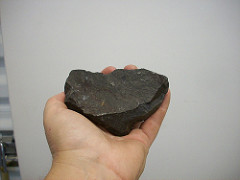
Magnetite

answer
Gray-black H=6; magnetic
question
Muscovite Mica
answer
A colorless mica one perfect cleavage; peels into flexible sheets
question
Olivine
answer
Commonly as aggregates of green granular crystals
question
Orthoclase Feldspar
answer
Vitreous, Sub-Vitreous, Resinous Diaphaneity (Transparency):Transparent, Translucent Comment:Slightly pearly on cleavage Colour:Colorless to white, Greenish white, Grayish yellow, Pale pink Streak:White Hardness (Mohs):6 Hardness Data:Mohs hardness reference species Tenacity:Brittle Cleavage:Perfect Perfect on {001}, good on {010} Parting:On {100} {110} {110} {201} Fracture:Irregular/Uneven, Conchoidal Density:2.55 - 2.63 g/cm3 (Measured) 2.563 g/cm3 (Calculated)
question
Plagioclase Feldspar
answer
Color Typically white to gray, may also range from colorless, through shades of off-white, to yellowish, pink, reddish brown or nearly black. Cleavage One perfect cleavage and one good cleavage that meet at nearly 90° Hardness 6 to 6.5 (harder than glass) Specific Gravity Increases from 2.6 to 2.8 depending on amount of calcium Luster Crystals are vitreous (glass-like) to porcelaneous (porcelain-like) Streak White Special Features Common twinning in the crystal structure that creates fine parallel grooves or striations on some cleavage surfaces.
question
Pyrite

answer
Brassy gold color, hardness, and black streak are diagnostic. cubic crystals with striations on their faces or in 12-sided crystals with five-sided faces
question
Pyroxene
answer
Two cleavages at 87 degrees and 93; major constituent of mafic and ultra mafic igneous rock
question
Quartz

answer
Wide range of colors; six-sided crustal shape, high hardness and conchoidal fracture and diagnostic
question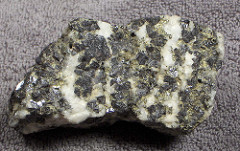
Sphalerite

answer
Wide variety of colors- including colorless; distinctive pale yellow streak
question
Talc
answer
Greasy feel H=1
question
Sedimentary Rocks
answer
are types of rock that are formed by the deposition and subsequent cementation of that material at the Earth's surface and within bodies of water. Sedimentation is the collective name for processes that cause mineral and/or organic particles (detritus) to settle in place.
question
Bituminous Coal
answer
Crystalline texture with accumulation of organic material, more lithified than lignite, usually shiny black in color
question
Breccia
answer
Clastic texture with (bigger than sand-size), angular rock fragments.
question
Chert
answer
Crystalline texture containing silica with siliceous composition
question
Conglomerate
answer
Classic texture with large (bigger than sand-size), rounded rock fragments
question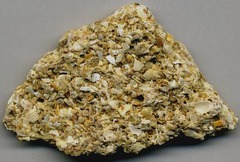
Coquina

answer
a soft limestone of broken shells, used in road-making in the Caribbean and Florida. 2. a small bivalve mollusk with a wedge-shaped shell that has a wide variety of colors and patterns.
question
Clastic
answer
aggregate of mineral grains/rock particles or fragments of organic remains
question
Crystalline
answer
Composed of interlocking crystals
question
Carbonate
answer
Mainly the mineral fragments of calcite or dolomite, or chemical precipitates of calcite, or calcite plant or animal remains
question
Siliceous
answer
Mainly quartz grains, or a precipitate of silica, or an accumulation of siliceous plant or animal remains
question
Evaporites
answer
Formed by chemical precipitation when saltwater evaporates (gypsum or halite)
question
Organics
answer
Certain remnants of organic chemicals and may be more than 90 percent of carbon
question
argillaceous
answer
rocks contain mostly clay
question
Sandstone
answer
Classic texture with sand-sized particles
question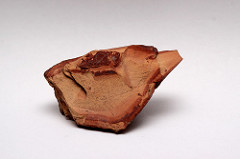
Shale

answer
Clastic texture with clay-sized (not visible with naked eye) particles argillaceous composition
question
Limestone
answer
Crystalline or clastic texture containing calcite with carbonate composition
question
Fossiliferous Limestone
answer
Clastic Texture with visible fossils, carbonate composition
question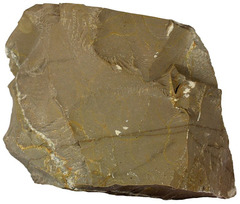
Micrite

answer
clastic texture (very small grains), carbonate composition
question
Peat
answer
Clastic texture with accumulation of organic material, can see plant fragments easily broken into pieces
question
Lignite Coal
answer
Clastic texture with accumulation of organic material, more lithified han peat, usually brown in color
question
Bituminous Coal
answer
Crystalline texture with accumulation of organic material, more lithified than lignite, usually shiny black color
question
Metamorphic Rock
answer
Rock whose origin is from the physical and/or chemical change of pre-existing rocks by exposing them to higher temperatures and or pressures and or passage of fluids
question
Foliated
answer
parallel arrangement of minerals into distinct layers or bands
question
non foliated
answer
doesn't have foliated texture
question
gneiss
answer
foliated texture
question
schist
answer
foliated texture
question
slate
answer
foliated texture
question
quartzite
answer
non-violated, quartz composition
question
phyllite
answer
foliated texture
question
marble
answer
non-foliated, carbonate, calcite or dolomite comp
question
anthracite coal
answer
non foliated, organic matter
question
Granite

answer
Coarse grain (phaneritic), Felsic Common minerals: quartz, orthoclase feldspar, muscovite mica, biotite mica, lesser amounts of amphibole
question
Rhyolite
answer
Fine grained (aphanitic) felsic
question
Diorite
answer
Coarse grained (phaneritic), intermediate
question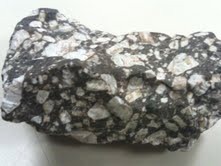
Andesite

answer
Fine-grained (aphanitic), Intermediate
question
Gabbro
answer
Coarse-grained (phaneritic), Mafic Common minerals: plagioclase feldspar, pyroxene, olivine lesser amounts of amphibole
question
Basalt
answer
Fine-grained (aphanitic), Mafic
question
Rhyolite porphyry
answer
Porphyritic, microscopic crystals are felsic
question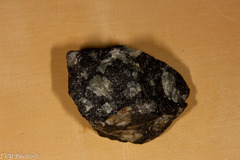
Basalt porphyry

answer
Porphyritic, microscopic crystals are mafic
question
Peridotite
answer
Ultramafic in composition (contains mostly olivine)
question
Obsidian

answer
Glassy in texture
question
Pumice
answer
Porous (vesicular) texture, vesicles are small, extremely light in weight
question
Scoria
answer
Porous (vesicular) texture, vesicles are large and numerous
question
Vesicular Basalt
answer
Porous (vesicular) texture, magic
question
Coarse-Grained (phaneritic)
answer
minerals are macroscopic in size
question
Fine-grained(aphanitic)
answer
Minerals are microscopic in size
question
Porphyritic
answer
A mixed texture in which macroscopic crystals are embedded in a matrix of microscopic crystals
question
Porous (vesicular)
answer
Igneous rock with vesicles- vesicles are holes, usually spherical to tubular, to oval shape
question
Glassy
answer
Looks like glass- smooth and shiny
question
Mafic
answer
igneous rocks that contain lots of magnesium, calcium and iron rich minerals. These rocks are usually dark colored
question
Felsic
answer
Igneous rocks that contain lots of minerals that have compositions like feldspars, these rocks are usually light in color.
question
Intermediate
answer
Have both mafic and felsic components
question
amphibole

answer
two cleavage directions, 60 & 120 degrees; nonmetallic, dark colored, vitreous; 5-6 hardness (About the same as glass)
question
biotite mica
answer
cleavage in one direction; thin sheets, transparent, nonmetallic, dark colored; vitreous 2.5-3 hardness (softer than penny)
question
calcite
answer
cleavage in 3 directions at 90; 3 hardness (harder than a penny, softer than glass); colorless, non metallic, light colored
question
fluorite
answer
cleavage in 4 directions; colorless, purple, green, cube shaped crystals, non metallic, light colored; 4 hardness (harder than penny, softer than glass)
question
galena
answer
3 cleavage directions at 90; metallic luster, silvery or battleship gray; 2.5 hardness (softer than glass, harder than a penny)
question
graphite

answer
one cleavage direction; gray-black, silvery, platy appearance, metallic luster; 1-2 hardness (softer than a fingernail)
question
gypsum

answer
prominent cleavage in one direction; white or colorless, splits into slabs, massive majority is fine grained, granular, non metallic, light colored; 1.5 hardness (softer than fingernail)
question
halite
answer
cleavage in 3 directions at 90; colorless, cube shaped crystals, tastes salty, non metallic, light colored; 2-2.5 hardness (softer than penny, harder than fingernail)
question
hematite
answer
no cleavage; earthly luster, may occur in smooth mounds, nonmetallic, dark colored; 5-6.5 hardness (softer than glass harder than a penny)
question
kaolinite
answer
cleavage in one direction rarely seen; white, typically powdery masses, sticks to the tongue, non metallic, light colored; 2-2.5 hardness (softer than fingernail)
question
magnetite

answer
no cleavage; magnetic, black or dark gray, black streak, metallic luster; 5.5-6.5 hardness (harder than a glass plate)
question
muscovite mica
answer
perfect cleavage in one direction; white or colorless streak, colorless or light tan or yellow, can be peeled into transparent sheets, non metallic; 2-2.5 hardness (softer than a fingernail)
question
olivine
answer
conchoidal fracture; green, may occur in granular masses, nonmetallic, dark colored; 6.5-7 hardness (harder than glass)
question
orthoclase feldspar
answer
cleavage two directions at 90; colorless, salmon, gray, green, white, stubby prismatic crystals, three polymorphs, non metallic, light colored; 6 hardness (harder than glass)
question
plagioclase feldspar
answer
cleavage in two directions at 90; colorless, white, gray, black, solid solution between sodium and calcium, non metallic, light colored; 6-6.5 hardness (harder than glass or knife softer than a streak plate)
question
pyrite

answer
conchoidal fracture; black streak, brassy yellow, commonly in 12 sided crystals or cubes with striated faces, metallic luster; 3.5-4 hardness (harder than a penny)
question
pyroxene
answer
cleavage in two directions; dark green or brown, commonly in elongate crystals, nonmetallic, dark colored; 5-6 hardness (about same as glass)
question
quartz

answer
conchoidal fracture; variable color, often in elongate six-sided crystals, non metallic, light colored; 7 hardness (harder than glass)
question
sphalerite

answer
six directions not all visible at once; brown, black, white, resinous luster, cream-colored streak, nonmetallic, dark colored; 3.5-4 hardness (harder than a penny, softer than glass)
question
talc
answer
prominent cleavage in one direction; white, gray, feels greasy, non metallic, light colored; 1 hardness (softer than fingernail)
question
bituminous coal
answer
organic, carbon, <1/256, black, may have subtle bedding, typically breaks into blocks, may contain plant fossils, 85% carbon, medium hard
question
breccia
answer
silici-clastic, gravel, >2, clasts are bigger than peas, you can measure clasts with a ruler, angular clasts
question
chert
answer
chemical, quartz, <1/256, grains are too small to see, tends to be porcelainous, very hard, fractures concoidally, crystalline, siliceous
question
conglomerate
answer
silici-clastic, gravel, >2, clasts are bigger than peas, you can measure clasts with a ruler, rounded clasts
question
coquina

answer
biochemcial, calcite, >2, a weakly cemented hash of shells
question
fossiliferous limestone
answer
biochemical, btwn 1/256 and 2, tends to be grayish, reacts with acid, visible fossils
question
lignite coal
answer
organic, carbon, <1/256, black, typically breaks into blocks, may contain plant fossils, 50% carbon, fairly soft, clastic texture
question
micrite

answer
biochemical, btwn 1/256 and 2, tends to be grayish, reacts with acid, very fine grained
question
peat
answer
organic, carbon, <1/256, black, may have subtle bedding, typically breaks into blocks, may contain plant fossils, softest coal
question
sandstone
answer
silici-clastic, sand, 1/16 to 2, grains are easily visible and identifiable with a ruler
question
shale

answer
silici-clastic, clay, <1/256, individual grains are not visible, composed dominantly of clay, breaks into thin plates
question
anthracite coal
answer
organic, carbon, <1/256, black, may have subtle bedding, typically breaks into blocks, may contain plant fossils, 95% carbon, quite hard
question
gneiss
answer
foliated, layered, quartzo-feldpsathic and aluminou, highest grade
question
marble
answer
nonfoliated, calcareous
question
phyllite
answer
foliate fine grained, aluminous 2nd grade
question
quartzite
answer
non foliated, quartzo-feldspathic
question
schist
answer
foliated, mafic
question
slate
answer
foliated fine grained, lowest grade
question
andesite

answer
fine-grained (aphanitic), intermediate
question
basalt
answer
aphanitic, mafic
question
basalt porphyry

answer
porphyritic, microscopic minerals are mafic
question
diorite
answer
coarse-grained (phaneritic), intermediate
question
gabbro
answer
phaneritic, mafic
question
granite

answer
phaneritic, felsic
question
obsidian

answer
glassy, mafic
question
peridotite
answer
ultramafic in composition, contains mostly olivine, phaneritic
question
pumice
answer
porous vesicular texture, small vesicles, extremely light weight, felsic
question
rhyolite
answer
aphanitic, felsic
question
scoria
answer
porous, vesicles are large and numerous, intermediate to mafic
question
vesicular basalt
answer
porous, mafic

